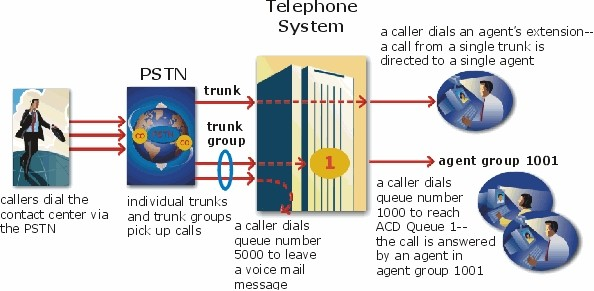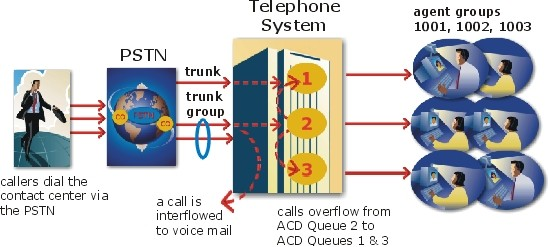Automatic Call Distribution
Automatic Call Distribution (ACD) is a specialized mechanism for distributing incoming calls. The primary goal of ACD is to ration calls to agents in a cost-effective manner that provides acceptable service to callers.
To optimize the use of agents, you cross-train them so they can handle a variety of inquiries. Rather than distributing calls to a number of small, specialized agent or extension groups, ACD distributes them efficiently among the entire pool of available agents. When you consolidate resources (use the Pooling Principle), the same number of contact center agents handle more calls while maintaining Service Levels.
Typically, you setup ACD to ensure the first call to arrive reaches the first available agent or the agent who has been idle the longest. However, you can vary the order of calls and agents to provide superior service to preferred customers, and skills-based routing.
UNDERSTANDING ACD CALL FLOW
The path of an incoming call is as follows. A caller telephones your contact center via the Public Switched Telephone Network (PSTN). (The PSTN is a global collection of Central Offices (COs) interconnected by long-distance telephone switching systems.) The local CO directs the call to one of your trunk groups. An available trunk picks up the call. Typically, calls from the PSTN arrive to the contact center over incoming trunks and calls from the contact center to the PSTN travel over outgoing trunks. If no trunks are available, the call does not get through to the system (it is blocked) and the caller receives a busy signal.
When a trunk picks up a call, it forwards it through to a group of agents handling calls, or to some other answering point. The call arrives at the ACD queue of an agent group. The queue delays the call rather than blocking the call from entering the system. The length of time the caller waits in queue is the queue time. While waiting in queue, the caller listens to product features, announcements, or other messages provided by a Recorded Announcement Device (RAD). The caller can wait patiently in queue for an available agent, leave a voice mail message, or hang up (abandon) the call. (See Figure 1.)
An agent handles the call. The time the caller spends talking to the agent is the ACD Handling Time (including the hold time). If the agent calls the supervisor in search of more information (while the caller is on hold) and/or transfers or conferences the call, these times are added to the ACD Handling Time value.
For example, an agent speaks to a caller for two minutes and then puts the caller on hold for three minutes and tries to solve the problem. This may include a call to the supervisor. The agent then initiates a conference call with the caller and a third party and they speak for three minutes and resolve the issue. Therefore, the ACD Handling Time for the agent is 2 + 3 + 3 = 8 minutes.
When the call is completed, the agent might need to perform additional work associated with the call. The time taken to perform this work is the Wrap Up Time.

Figure 1: Call flow
Monitoring the call flow process
Second-by-second (real-time) statistics presented on wall signs and desktop monitors enable you to monitor the service provided to callers. You can monitor the number of incoming calls, the time it takes to process them, the queue load, and the availability of agents using a Management Information System (MIS). The MIS refers processes data produced by the telephone system. The MIS uses telephone system records to provide forecasting, real-time monitoring, and reporting functions.
Ensuring traffic-carrying efficiency
To optimize traffic-carrying efficiency ensure
• Sufficient trunks are available to carry incoming calls.
• Callers experience a delay in queue.
• There is a random distribution of calls among available agents.
Scheduling to optimize call flow
You schedule agents so the number of incoming calls at any given time typically exceeds the number of agents currently available. The intent is that callers experience a slight delay before
agents answer their calls. The expected number of incoming calls forecasted for the time of day, and day of the week influence scheduling decisions.
Routing calls
Call routing options you program in the telephone system provide a set of instructions that automate the movement of calls to their intended answering points. You can define options-for example, if the caller dials 1, the system forwards the caller to customer service. You can specify re-routing for calls not answered after a set period of time and parse incoming Automatic Number Identification (ANI) and Dialed Number Identification Service (DNIS) data to direct call routing. (See Figure 2.)

Figure 2: Call routing
Dialing an agent's extension
In the simplest call scenario, a single trunk picks up an incoming call to your contact center. The telephone system presents the caller with options to dial various answering points. The caller dials an individual agent at an extension through a queue number. A queue number is an address mechanism for a queue or other answering point. The programming associated with the queue
number defines the routing and timing features of the call. The telephone system collects data on the agent and trunk involved in the call. The ACD management reporting application produces reports on agent and trunk activity.
Dialing a queue
In the next call scenario a trunk group picks up an incoming call to your contact center. The system presents the caller with options to dial various answering points. The caller dials queue number 1 to reach queue 1 (Customer Service). The system forwards the call to the first available agent in the agent or extension group associated with queue 1. The call is an ACD call because one dialable number represents all of the agents in the group. The telephone system collects data records for the call. The ACD management software produces Queue Reports on queue 1.
Overflowing calls
An ACD call that is not answered immediately is placed in a queue. If an agent does not pick up the call after a set amount of time (the overflow time) the system places the call in the queue of another agent group, in addition to keeping it in the first queue. The first available agent in either group handles the call. The overflow feature limits the delay faced by callers by queuing calls against two or more agent groups. (See Figure 3.)

Figure 3: Multiple queue routing
lnterflowing calls
You can program the ACD routing system to direct a queue delayed call to voice mail or to another answering point. The interflow timer runs independently of the overflow timer. If the interflow timer expires, the system removes the call from the queue and re-directs it to another answering point, such as a trunk or voice mail.